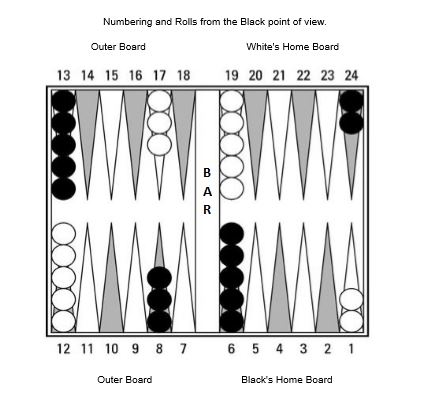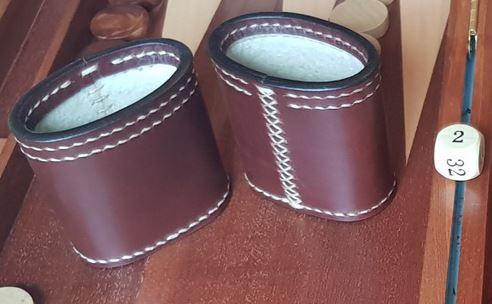Last updated on July 13, 2024
In this Deluxe Backgammon post for absolute beginners, we will take a look at 6 simple steps to get started playing a game of backgammon. You can learn how to play backgammon with this simple guide.
1. Set up the backgammon board
First, you need to set up the board. A backgammon board is divided into four quadrants as shown in the diagram below. The board is shown from the perspective of the black checkers and is numbered accordingly.
Each player will set up 15 checkers on the board. 2 checkers on the 24-point, 5 checkers on the 13-point, 3 checkers on the 8-point, and 5 more on the 6-point.
2. Roll the dice to start the game
Each player will have 2 dice and a dice cup. The dice cup is designed to prevent manipulation (cheating) of the dice rolls. To start the game both players roll a single die from their dice cup into the right-hand side of the board. If the dice rolls are identical, they are re-rolled. The player throwing the higher number moves first according to the numbers showing on both dice. After the first roll, the players throw two dice and alternate turns. There is a minor statistical advantage to the player going first.
The two numbers you get from rolling the dice represent the number of moves you can make. You can make two separate moves with two separate checkers, or combine the numbers you get and move one checker. However, if you are using both numbers to move a single checker it needs to take two separate moves across open points. For example, a roll of 4-5. This is played using a single checker moved in two separate moves of 4 and 5. It is not a single move of 9.
You can move your checker to any open point as long as there are less than 2 of the opponent’s checkers on that point.
If you roll doubles, you receive two extra moves. A roll of 6-6, means that you have four moves of 6 to take.
If you can’t find an open point with the numbers you’ve rolled, you forfeit your turn.
3. Beginners tips
While you can start moving with any checker you choose, it’s often wise to get your back checkers moving to avoid them being trapped. There are a series of recommended opening moves, whilst other combinations have alternate moves available.
Try to avoid having only one checker on a point as you could get hit by your opponent’s checkers. This means you have to re-enter from the bar, which puts you behind in the race. A single checker is known as a blot. You should be careful where you leave blots.
Try to spread out your checkers on secure points of 2s and 3s to block out your opponent. Avoid creating ‘candlesticks’ of 4 or more checkers as this is a waste of material.
There is a range of different tactics and strategies that can be applied during play. These will often change during the course of a game as the positions change and the luck of the dice influences play. At its core, backgammon is a race and whether you are in front or behind will influence your choice of strategy. Understanding the pip count is crucial to knowing your position in the race.
4. Hitting and Entering
When you land on a blot, which is a point occupied by only one of the opponent’s checkers, that checker is considered hit and is placed on the bar. The opponent cannot move any of their other checkers until they re-enter the checker from the bar back into your home board.
The only way to re-enter from the bar is to roll a number that corresponds to an open point within the opponent’s home board. The number has to be from a single die, you cannot add the sum of the dice rolls for re-entry. For example, if you roll 1-2, you cannot add the values together to land on the 3-point. You must re-enter on the 1 or 2 points if they are open. Once re-entered the extra roll could be used to move to the 3-point.
5. How to win the game
To win at backgammon, you must be the first to bear off all of your checkers from the board. In order to start bearing off, all of your checkers must be in your home board. If one of your checkers is hit during the bearing-off process. The checker must be re-entered. It then must move all the way back to the home board before you can bear off any more checkers. To bear off a checker, the dice roll needs to be exact or higher than the spaces needed to remove each piece. As per the rules, both dice must be played if it is possible to do so. If either of the rolls is playable, but not both, the highest dice roll must be played.
6. Money play or match play
Backgammon can be played as a single game, known as money play or as a series of games, known as match play. The term money play does not necessarily mean that betting is involved. It simply indicates that the result is determined by the outcome of a single game. In match play, a specific number of points is set as a target and the first player to reach that score over a series of games is the winner. The doubling cube and wins by a gammon or backgammon add to the number of points in each game. For example, a 5-point game could take as many as nine games to complete, if the doubling cube is not used and gammons or backgammons don’t occur. It could also be over in a single game if the doubling cube has been turned and there is a win by a backgammon.
For a relatively simple game that can be learnt in a matter of minutes, there is a surprising amount of complexity. You can enjoy the game as a social player and get a lifetime of enjoyment or you can dedicate yourself to mastering the game through years of study. Either way, the exciting mix of skill and luck makes backgammon one of the world’s most popular board games.
Related content
How to win at backgammon at wikiHow.




A useful guide for those starting out in backgammon. There are a lot of really interesting backgammon posts on this website. keep up the good work.
Perfect for backgammon beginners. I great starting point, any tips on improving for intermediates? I’m a social backgammon player, I’d like a little edge on my regular opponents!
Hi Donny, check out our 10 intermediates backgammons tips, the Back to basics post is useful for a backgammon refresher and, although you can’t use it in a game, don’t forget our Backgammon cheat sheet which has some great tips for intermediates. Thanks for taking the time to comment and enjoy your backgammon, Jason